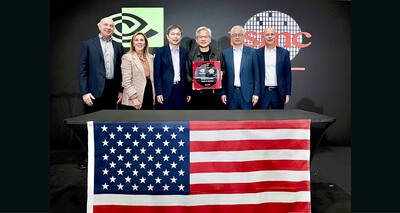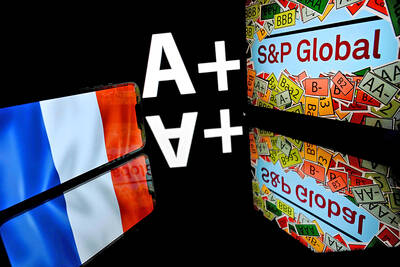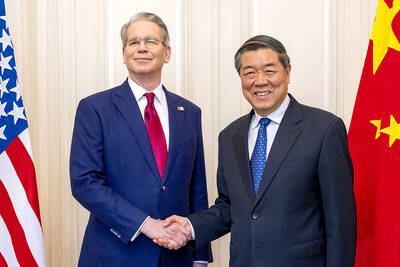Powertech Technology Inc (力成), a memorychip tester and packager, yesterday said it expects revenue this quarter to grow mildly from the previous quarter, while gross margin could also improve quarterly, driven by continued robust demand for DRAM chips for mobile and graphics devices.
“The overall market may face a slowdown in demand this quarter, but thanks to main clients’ demand for DRAM because of new smartphone launches, Powertech could still grow from last quarter,” company president JY Hung (洪嘉鍮) told an investors’ conference, without providing a sales estimate for this quarter.
Powertech chairman Tsai Du-kung (蔡篤恭) said the company’s DRAM business for mobile devices was good in the first six months, although Chinese and South Korean smartphone makers faced softer-than-expected demand in the period.
“We have very diversified smartphone clients,” Tsai said.
“We expect the demand for DRAM for mobile devices to remain strong in the second half and to drive Powertech’s overall revenue performance,” he said.
Hung said growing demand for servers worldwide has brought higher orders for advanced DRAM chips used in high-end servers, which might also boost the company’s revenue this quarter.
The company expects sales contributions from its overall DRAM business to increase to about 45 percent this quarter from last quarter’s 36 percent, Hung said.
Hung said the company foresees orders growing this quarter in its flash memory business — which accounted for 35 percent of Powertech’s total revenue last quarter — on the back of the increasing demand for high-end smartphones and solid-state drives.
However, logic IC business, which contributed 29 percent of Powertech’s sales last quarter, is expected to be flat from last quarter, Hung said.
The logic IC business is expected to grow significantly in the final quarter, fueled by clients’ new projects, he said.
Last quarter, net income dropped 3.1 percent to NT$1.18 billion (US$37.37 million) from a year earlier, mainly due to higher operating expenses due to wage raises, Powertech said.
On a quarterly basis, profit jumped 15.68 percent, the company said.
Earnings per share were NT$1.2 last quarter, up from last year’s NT$1.18 and the prior quarter’s NT$1.01, it said.
Powertech’s gross margin last quarter was 18.7 percent, an improvement from 18.1 percent last year and 17.7 percent the previous quarter on better product mix, Hung said.
“We will maintain this product portfolio and increase the utilization of production capacity to keep improving gross margin this quarter,” he said.
Powertech shares surged 3.81 percent to NT$51.8 in Taipei trading yesterday, ahead of the firm’s investors’ conference, outperforming the TAIEX, which gained 0.3 percent.

Jensen Huang (黃仁勳), founder and CEO of US-based artificial intelligence chip designer Nvidia Corp and Taiwan Semiconductor Manufacturing Co (TSMC, 台積電) on Friday celebrated the first Nvidia Blackwell wafer produced on US soil. Huang visited TSMC’s advanced wafer fab in the US state of Arizona and joined the Taiwanese chipmaker’s executives to witness the efforts to “build the infrastructure that powers the world’s AI factories, right here in America,” Nvidia said in a statement. At the event, Huang joined Y.L. Wang (王英郎), vice president of operations at TSMC, in signing their names on the Blackwell wafer to

AI BOOST: Although Taiwan’s reliance on Chinese rare earth elements is limited, it could face indirect impacts from supply issues and price volatility, an economist said DBS Bank Ltd (星展銀行) has sharply raised its forecast for Taiwan’s economic growth this year to 5.6 percent, citing stronger-than-expected exports and investment linked to artificial intelligence (AI), as it said that the current momentum could peak soon. The acceleration of the global AI race has fueled a surge in Taiwan’s AI-related capital spending and exports of information and communications technology (ICT) products, which have been key drivers of growth this year. “We have revised our GDP forecast for Taiwan upward to 5.6 percent from 4 percent, an upgrade that mainly reflects stronger-than-expected AI-related exports and investment in the third

France cannot afford to ignore the third credit-rating reduction in less than a year, French Minister of Finance Roland Lescure said. “Three agencies have downgraded us and we can’t ignore this cloud,” he told Franceinfo on Saturday, speaking just hours after S&P lowered his country’s credit rating to “A+” from “AA-” in an unscheduled move. “Fundamentally, it’s an additional cloud to a weather forecast that was already pretty gray. It’s a call for lucidity and responsibility,” he said, adding that this is “a call to be serious.” The credit assessor’s move means France has lost its double-A rating at two of the

RARE EARTHS: The call between the US Treasury Secretary and his Chinese counterpart came as Washington sought to rally G7 partners in response to China’s export controls China and the US on Saturday agreed to conduct another round of trade negotiations in the coming week, as the world’s two biggest economies seek to avoid another damaging tit-for-tat tariff battle. Beijing last week announced sweeping controls on the critical rare earths industry, prompting US President Donald Trump to threaten 100 percent tariffs on imports from China in retaliation. Trump had also threatened to cancel his expected meeting with Chinese President Xi Jinping (習近平) in South Korea later this month on the sidelines of the APEC summit. In the latest indication of efforts to resolve their dispute, Chinese state media reported that